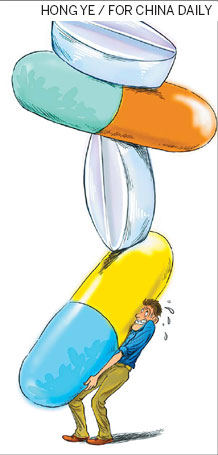Bitter medicine for sick people
Updated: 2011-12-19 07:54
By Liu Jie (China Daily)
|
|||||||||
Pharmaceutical companies are also obliged to report their production conditions, and the retail and hospital prices of their Chinese-made products to the NDRC or provincial-level pricing departments.
Xu Deren, a medical industry researcher for the Hong Kong-based consultancy KGI Securities, said the NDRC is making an effort to discover the real cost of medicines, thus paving the way for price reductions. "The ceiling prices set by the commission or local departments are expected to further decrease, resulting in a general reduction in prices," he said.
Price setting
|
|
To set the price of medicines, China uses a ceiling-price system, combined with bidding for reimbursement levels or to gain entry to the list of essential drugs.
When a medication is due to go on the market, the drugmaker should calculate the costs, usually in two parts - the production costs, also known as the manufacturer's price, and the commercialization costs. The first part involves funds invested in research and development - if it's an innovative new product, raw materials, human resources, equipment, and the consumption of water and electricity. Meanwhile, the second part of the equation includes management and fiscal expenditure, distribution costs and expenditure on marketing, sales and advertising.
The drugmaker should also hand over related files to the NDRC or local pricing department. The authorities will then establish a "ceiling" or the highest price for the medicine, based on the various costs and the real market conditions.
The NDRC formulated China's national reimbursement drug list (NRDL), covering basic medicines. Meanwhile, the medicine bidding and purchasing departments of various municipalities, provinces and autonomous regions additionally map out their own EDLs in line with local conditions.
After the medicine is given a ceiling price, it may be included in NRDL or EDL bidding, at the price determined by the drugmaker and not higher than the ceiling price. If accepted, the hospital price for the drug will be the bidding price plus a commission of 15 percent, which is paid to the hospital.
"So, if we say hospital prices are vastly higher than those charged by the manufacturer, where does this disparity come from? You can clearly see that's from the second part (of the equation), this part can be really flexible," said Zhuang Yiqiang, deputy general-secretary of the Chinese Hospital Association, adding that those costs feed distribution companies, medicine sales, advertising agencies as well as some doctors.
Knowing the price-setting procedure, the public may be suspicious as to why the NDRC and the local pricing departments set such high ceiling prices and why bidding prices are allowed to rise so high.
Gu Xin, a professor at the School of Government at Peking University, said government pricing control is the key cause of high medicine prices, adding that this sort of pricing system often results in bribery and corruption at different levels, ranging from governmental institutions to grassroots hospitals. "We should adopt a market-oriented pricing reform and set up a strict supervisory framework for the pharmaceutical industry to solve the problem," he said.












